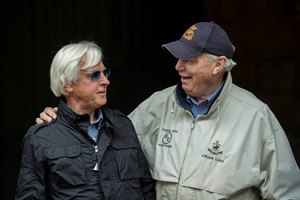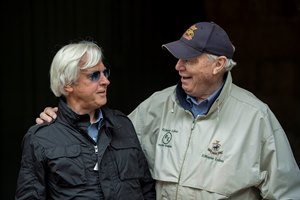'Bob and Wayne Show' Hard to Beat at Preakness


The big red horse had just completed his final bit of training in preparation for the next major test he will attempt to ace, and with the backdrop of camera clicks serving as his soundtrack, he took turn after turn around the shedrow showing off the good flesh that has seemingly been impervious to the demands it has encountered. But as the media and onlookers focused on unbeaten Kentucky Derby Presented by Woodford Reserve (G1) winner Justify a day before his slated run in the middle leg of the Triple Crown, the real spectacle was playing out at the far end of the Pimlico Race Course stakes barn May 18—as it has for the better part of multiple decades.
Hall of Famers Bob Baffert and D. Wayne Lukas had planted themselves in the other's presence and were swapping jabs and stories in the way only the two men who have seen everything the sport has to offer can. Among their litany of entertaining topics Friday morning were talks about their respective college days, their fraternity experience, and what each had to endure during what passed for "Hell Week" in their day.
"They only let us sleep an hour a day," Baffert recalled of his pledge time, adding with barely a pause, "It was probably what it'd be like working for you, Wayne."
Such back-and-forth between the two legendary conditioners has become one of the great traditions of Preakness Stakes (G1) week, as the practice of putting the race contenders in a shared barn allows them regular access to each other's wit and wisdom.
It is an especially fitting byproduct given that the Baltimore jewel has served as the most abundant showcase of the intangibles that define the two masters of the classics.
For all the greats that have laid claim to the Woodlawn Vase in the 143-year-old history of the Preakness Stakes, no trainers in the modern era have worked the 1 3/16-mile race the way Baffert and Lukas have. With six wins apiece, the two are tied for second-most Preakness victories behind only R. W. Walden, who won seven from 1875-1888. And if Baffert's latest beast, Justify, holds the form that carried him to a 2 1/2-length victory over champion Good Magic in the Kentucky Derby two weeks ago, come Saturday the white-haired one is going to be one step closer to owning that mark outright.
To cite their obvious ability as horsemen is only a cursory explanation as to why Baffert and Lukas have owned the Black-Eyed Susans in an era that has been packed with exceptional handlers of horseflesh. Where others have come to Maryland with seemingly brilliant Kentucky Derby winners only to watch the wheels come off, Baffert is four-for-four when shipping in one that prevailed on the first Saturday in May. And when it comes to ruining would-be Triple Crown aspirations, Lukas is the king of the killjoys as Charismatic (1999) is his only Preakness winner that captured the prior 10-furlong classic.
If the game has evolved in the 22 years since Baffert saddled his first Preakness starter in Cavonnier (fourth in 1996), it has about done a 180 in the decades since Lukas prevailed in his first try with Codex in 1980. What hasn't budged is the fact their peers take exceptional heed whenever one of theirs steps off the van at Old Hilltop.
"The thing is, both of us come from the school of getting them ready and asking them to (perform). When they're good, we'll lead them over there. Bob and I come from that same mold, and our horses are very similar in the way they run," said Lukas, who is set to saddle grade 1 winner Sporting Chance and grade 2 winner Bravazo in Saturday's Preakness. "Very seldom do you see a Baffert or a Lukas horse drop way back and make a big sweeping run. We're right up there.
"I think with Bob, he has run the best horse—that's the first thing (with his Preakness success). He ran the best horse in the Derby … he usually has the best horse, (while) we're trying to get a maximum move forward on horses who are probably lesser quality. It doesn't always work, but we've had pretty good luck with it."
Having the talent and knowing how to read and harness the subtle means that go with it is a massive reason behind the Preakness routinely becoming 'The Bob and Wayne Show.'
With more time between starts taking over as the trend in racing, many trainers approach the 14-day turnaround between the Kentucky Derby and Preakness with trepidation, despite the fact only seven horses since 1980 have reigned as Preakness winners without starting in the Derby. Having each come from a Quarter Horse background, where wheeling back on short rest is the norm, Baffert and Lukas have made an art form out of knowing how to channel a horse's form cycle once it gets at or near its peak.
"Wayne and I, we're from the Quarter Horse world where we have to run them one week and then come back and run for all the money the next week," Baffert said. "We know how it is. We know the turnaround because we've dealt with the turnaround all our lives.
"A lot of these trainers, they want to give their horse extra time. But that's why I have a really great foundation in all my horses. Before (Justify) ran, he was really ready. I had him ready in case he had to run really hard and fast where it wasn't just going to knock him out. And that's why he has been able to recover quickly after every race."
Indeed, putting bottom into a horse is another shared trait of the two men who have combined to win 27 Triple Crown races. Neither Baffert nor Lukas is afraid to work their horses hard in the a.m. hours. But it takes a charge of a certain constitution to be able to thrive in those programs, and there is a common physicality they look for when evaluating which of their youngsters will be able to go through a prep season, endure the melee of the Kentucky Derby, and still have something in reserve a fortnight later.
"I think a little bit is the kind of horse we select," said Lukas, whose last Preakness win came with Oxbow in 2013. "In our 3-year-old picture, we select those horses that are probably a little bit tougher. I like the tough horses going into that. It's not a three-race series anymore. It's more like a five-race series with the prep races and everything, so we try to pick up horses who are really tough."
Added Elliott Walden, president of WinStar Farm, which co-owns Justify, "There are a lot of horses that come here and don't have it, but I feel good about Justify from the standpoint of his weight. He's a big horse and he has a lot of flesh, and I think that's key, too, to running back in two weeks. Maybe that is part of Bob's success. He buys big horses. He trains big, good-looking horses where there is just more to them. I think from a substance standpoint, it makes a big difference because in the Derby, if you gut yourself, it's hard to get turned around in two weeks."
Run them when they're right—it's one of the oldest philosophies in the Thoroughbred game. And in the decades Baffert and Lukas have spent picking each other's brains, crafting new tales, and pushing their already storied skill set, none have been better at getting their horses right at this point in the juncture when so many others start to wane.
"I remember with Lookin at Lucky (in 2010) … for the first five days (after the Kentucky Derby), I thought there was no way he's going to be able to (go to the Preakness)," Baffert said. "And it took him until Monday until he started showed some signs. It went from 'He's not running. I'm not going to run him back.' And the next Monday, I sent a text to the owners: 'He's going to run, and he can't lose.' So it can change dramatically."
